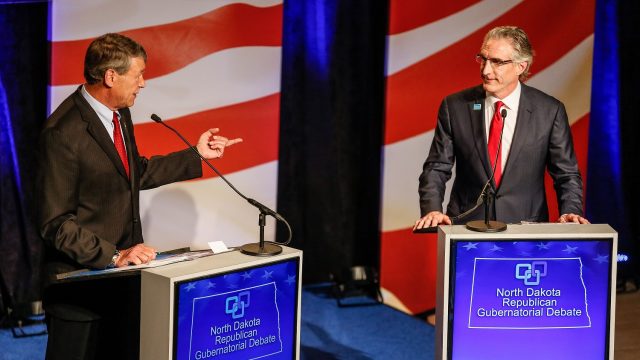Based On Early Voting North Dakota's 2016 Primary Looking To Have Above Average, But Not Exceptional, Turnout

North Dakota’s Republican gubernatorial primary – which, due to the incompetence of Democrats in this state, will basically choose our next governor – is going to be close, I think. It’s pitting Attorney General Wayne Stenehjem’s long history of high approval and landslide election victories against Fargo businessman Doug Burgum’s “political outsider” schtick and vast financial resources.
The conventional wisdom – for what that’s worth in this crazy election cycle – would tell us if voters are ready to make a change, which Burgum is pushing for, that turnout is going to be high. If they’re satisfied with the status quo, which Stenehjem represents, turnout will probably be low or about average.
So far, just eight days out from primary day, it’s looking like turnout is going to be a little above the average from the previous four cycles. As I write this there have been 20,952 early, absentee, and vote-by-mail ballots cast in the 2016 primary (see a county-by-county breakdown here). Here’s how that data stacks up with previous primary votes for the four previous election cycle via data from the Secretary of State’s office:

As you can see, the 2014 primary saw an unusually low number of early votes (there was just one measure on the statewide ballot dealing, ironically, with ballot measures). The 2012 cycle saw an unusually high number of early votes. That cycle also saw an unusually high turnout for a primary, probably because there four ballot measures including a referendum on legislation to keep the University of North Dakota Fighting Sioux logo/nickname, a measure to abolish property taxes, and a controversial religious liberty amendment to the state constitution:

Already we have more early voting in the 2016 primary than we did in 2014, but less still than any other cycle going back to 2008.
Voters must have their absentee and vote-by-mail ballots postmarked no later than the day before primary day. As I write this 38,480 absentee and vote-by-mail ballots have been issued, with just under 54 percent returned so far. In 2014 about 83.24 percent of those ballots were returned (that data for primaries before 2014 isn’t available).
If 2016 follows 2014 – and keep in mind that 2014 was a low-turnout year – the number of early votes cast would be just under 32,000.
Which would be about 3,745 votes higher than the 28,185 average from the four previous cycles.
Or slightly above average.
That’s probably not great news for Burgum, who is no doubt hoping to drive well above average turnout to the polls, but who knows. Burgum is running what has to be the most expensive campaign for state office North Dakota has ever seen, and we’re not even past the primary yet. We are in uncharted territory here.
Some have speculated that Burgum could be helped with a big turnout in left-leaning Fargo, his home turf and the state’s most populous area, where there are 11 people running for the city commission, 9 for the school board, and 5 for the park board. That could be a factor.
As for measures, there is just one on the ballot this June, a referendum of a corporate farming law passed by the Legislature last year. The North Dakota Farmer’s Union has invested a lot of money into getting its membership to the polls, but it’s not clear a) how many are going to turn out since the referendum hasn’t really been contested (plus the Farm Bureau says they’re suing over the law anyway) and b) which of these two Republican candidates the Farmer’s Union demographic might help.
Again, Burgum has invested big money into making this primary a referendum on the Republican “good old boy club.” If that were something getting a lot of traction, I feel like we’d see more voting activity than we have so far.
Which isn’t to say that Stenehjem is going to win. Only that Burgum’s flood of campaign spending doesn’t seem to be motivating turnout much outside the typical.




